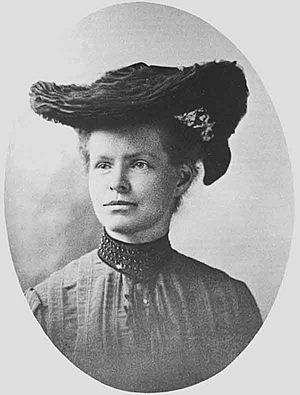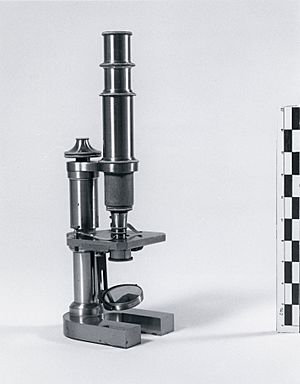Nettie Stevens facts for kids
Quick facts for kids
Nettie Stevens
|
|
|---|---|
 |
|
| Born |
Nettie Maria Stevens
July 7, 1861 Cavendish, Vermont, United States
|
| Died | May 4, 1912 (aged 50) Baltimore, Maryland, United States
|
| Education | Westford Academy |
| Alma mater | Westfield Normal School Stanford University Bryn Mawr College |
| Known for | XY sex-determination system |
| Scientific career | |
| Fields | Genetics |
| Institutions | Bryn Mawr College, Carnegie Institution of Washington |
| Thesis | Further studies on the ciliate Infusoria, Licnophora and Boveria (1903) |
| Doctoral advisor | Thomas Hunt Morgan |
| Doctoral students | Alice Middleton Boring |
| Influences | Edmund Beecher Wilson Thomas Hunt Morgan |
Nettie Maria Stevens (born July 7, 1861 – died May 4, 1912) was an American geneticist. She is famous for discovering sex chromosomes. These are the special parts of our cells that decide if we are male or female.
Contents
Early Life and Family
Nettie Maria Stevens was born in Cavendish, Vermont, on July 7, 1861. Her parents were Julia and Ephraim Stevens. When Nettie was two years old, her mother passed away. Her father later remarried, and the family moved to Westford, Massachusetts. Nettie's father worked as a carpenter. He made sure Nettie and her sister, Emma, received a good education through high school.
Nettie's Education Journey
Nettie was a very bright student and often at the top of her class. She and her sister Emma were two of only three women to finish high school at Westford Academy between 1872 and 1883. After graduating in 1880, Nettie taught high school subjects. She taught zoology, math, English, and Latin in Lebanon, New Hampshire.
After three years of teaching, she went back to Vermont to study more. Nettie continued her education at Westfield Normal School, which is now Westfield State University. She finished a four-year course in just two years! She graduated with the best scores in her class.
In 1896, Nettie wanted more science training. She enrolled at the new Stanford University. She earned her first degree (B.A.) in 1899 and a master's degree (M.A.) in biology in 1900. She became very interested in histology, which is the study of tissues.
Studying Cells at Bryn Mawr
After Stanford, Nettie went to Bryn Mawr College to earn her Ph.D. in cytology. This is the study of cells. She studied how simple animals grow back parts and how cells divide. She also looked at the cells that create new life in insects.
During her studies, Nettie won a special award. This allowed her to spend a year (1901–1902) studying in Europe. She worked with sea creatures in Naples, Italy, and studied at a university in Germany.
When she returned to the United States, her Ph.D. advisor was the famous geneticist Thomas Hunt Morgan. Nettie earned her Ph.D. from Bryn Mawr in 1903. She stayed at the college as a researcher until she passed away. Just before her death, she was offered a job as a research professor, but she was too ill to accept.
Research at Carnegie Institute
After getting her Ph.D., Nettie received a research grant. This was from the Carnegie Institute of Washington in 1904–1905. She applied for money to study how traits are passed down, especially sex determination.
She used tiny insects called aphids to see if male and female cells had different sets of chromosomes. In 1905, one of her papers won her an award of $1,000. This was for the best scientific paper written by a woman. Her main work on sex determination was published in two parts. It showed her growing focus on how chromosomes decide sex.
In 1908, Nettie received another important fellowship. This allowed her to do more research in Europe. She visited laboratories and continued her studies in Italy and Germany.
Nettie's Science Career
Nettie Stevens was one of the first American women to be recognized for her science work. Most of her research happened at Bryn Mawr College. She helped expand the fields of genetics, cytology (cell study), and embryology (study of development).
Even though she didn't have a regular university job, Nettie built her career by doing research. She worked at top marine stations and laboratories. She published 38 scientific papers. Many of these papers greatly helped the new ideas about how chromosomes carry traits.
By studying cells that create new life, Nettie figured out that chromosomes play a role in deciding sex. Her research gave important proof for the ideas of Mendel and the chromosomal theories of how traits are passed down.
Discovering Sex Chromosomes
Nettie studied insect chromosomes. She found that in some species, the chromosomes were different between males and females. This difference led to whether the offspring would be male or female. This was a huge discovery! It was the first time that visible differences in chromosomes could be linked to a visible difference in an animal's features, like being male or female. She published this work in 1905.
She continued her experiments using many types of insects. She found a small chromosome, now called the Y chromosome, in the mealworm. She realized that whether an animal was male or female depended on this small Y chromosome carried by the male.
Nettie studied eggs and how they are fertilized in aphids, mealworms, beetles, and flies. She saw chromosomes that came in small-large pairs (now known as XY chromosome pairs). She also saw chromosomes that were unpaired, called XO.
Another scientist, Hermann Henking, had studied firebug chromosomes earlier. He noticed the chromosome now called X, but he didn't find the small chromosome now called Y. Nettie realized that an earlier idea, that the X chromosome alone decided sex, was wrong. She showed that sex is decided by whether the small (Y) chromosome is there or not.
Nettie Stevens herself did not name the chromosomes X or Y. Those names came later.
At Bryn Mawr, after her 1905–06 publications, Nettie also raised and studied Drosophila melanogaster (fruit flies). She used them for her research for several years. Later, Thomas Hunt Morgan also started using fruit flies as a main animal for his studies.
Who Discovered Sex Chromosomes?
Nettie Stevens and another scientist, Edmund Beecher Wilson, both worked on how chromosomes determine sex. However, many people have given Wilson all the credit for the discovery. Also, Thomas Hunt Morgan has often been credited with finding sex chromosomes. But at the time of these discoveries, he actually disagreed with Nettie's and Wilson's ideas! Nettie was not even recognized right away. For example, in 1906, Morgan and Wilson were invited to speak at a conference about their theories, but Nettie was not invited.
Nettie's Passing
Nettie Stevens passed away from breast cancer on May 4, 1912, in Baltimore, Maryland. She was 50 years old. This was only nine years after she earned her Ph.D. Her career was short, but she published about 40 scientific papers. She never married and did not have children. She was buried in Westford, Massachusetts, next to her father and sister.
Nettie's Lasting Impact
In 1994, Nettie Stevens was honored by being added to the National Women's Hall of Fame.
To celebrate her 155th birthday on July 7, 2016, Google created a special picture called a "doodle." It showed Nettie looking through a microscope at XY chromosomes.
On May 5, 2017, Westfield State University honored Nettie Stevens. They named their new science building the Dr. Nettie Maria Stevens Science and Innovation Center. This center is where the university's science, nursing, and health programs are located.
See also
 In Spanish: Nettie Stevens para niños
In Spanish: Nettie Stevens para niños


